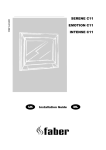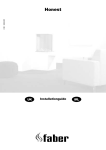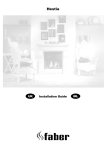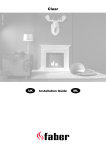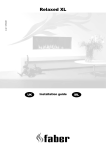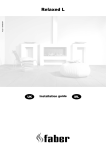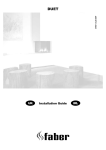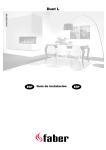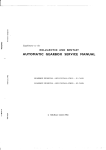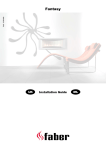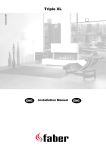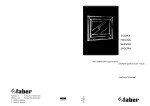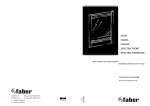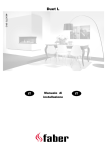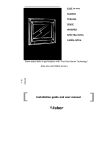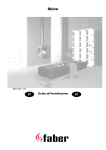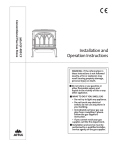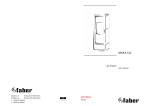Download installation guide
Transcript
Spectra Frameless 40010711 - 0812 UK Installation Guide IRL UK IRL Not in combination with Nostalgic backpanel 1.1 1.2 1<<<< NL/BE A C B D 1.3 1.4 1.5 1.6 >>>>2 UK IRL 2-1 Fig. 4.7 Stopbracket 2-2 Knurled screw 2-3 3<<<< 2-4 NL/BE Content 1 Introduction ......................................................................................... 1 2 Safety and general information .................................................................. 2 3 Installation requirements ......................................................................... 3 4 5 3.1 Builders opening and surround ............................................................. 3 3.2 Flue requirements............................................................................ 3 Instruction for Installation ........................................................................ 5 4.1 Gas Connection ............................................................................... 5 4.2 Preparing the appliance..................................................................... 5 4.3 Placing the appliance........................................................................ 5 4.4 False Chimney Brest without surround ................................................... 5 4.5 False chimney with surround ............................................................... 6 4.6 Logburner...................................................................................... 6 4.7 Flatburner ..................................................................................... 6 4.8 Removal of the glass......................................................................... 7 Commissioning (functional checks) .............................................................. 8 5.1 Pilot ignition check .......................................................................... 8 5.2 Check functional burner and pilot burner................................................ 8 6 Handing over (final check and customer briefing) ............................................ 9 7 Servicing ............................................................................................. 9 7.1 Routine anual servicing ..................................................................... 9 7.2 Cleaning the glass ............................................................................ 9 7.3 Cleaning the combustion chamber ....................................................... 10 7.4 Rebuild to other gas category (e.g. Propane/butane) ............................... 10 Appendix A: Example calculation..................................................................... 11 Appendix B: Flue restrictor............................................................................ 12 Appendix C: Installation of the flue.................................................................. 13 Appendix D: Technical specifications Logburner................................................... 14 Appendix E: Technical specifications Flatburner .................................................. 14 Appendix F: Dimensions Spectra Frameless......................................................... 15 Appendix G: Dimensions Spectra with Jellum 840 ................................................. 16 Appendix H: Dimensions Spetra with Wirdum 840 ................................................. 17 Appendix J: Dimensions Convection grid ............................................................ 18 >>>>4 UK IRL 1 Introduction Note: these instructions should be read carefully and retained for future reference. Please leave these instructions with the user. This manual covers both models. Both are developed to be installed in 3 ways: • Frameless in an existing builders opening or false chimney breast • in combination with the Jellum surround • in combination with the Wirdum surround Specific information about the installation of both surrounds can be found in the installation guide delivered with the Jellum and Wirdum surround. Details concerning the installation of the appliance in relation to the surrounds are explained in this installation guide. Special features: • Realistic flame and glow effect because of the Log Burner or Flat burner technology • Room sealed appliance, inlet and outlet are led to the outside using a natural draught concentric pipe system (100 mm/150 mm) (no power fan required) • Air supply and flue-gases go to outside atmosphere through wall or roof. • A maximum horizontal extension of 6 meters is (in certain cases) possible • Remote Control standard on both models • Meets the requirements of the European Gas Appliance Directive (GAD) and carries the CE mark 1<<<< UK IRL 2 Safety and general information Before installation, ensure that the local distribution conditions (identification of the type of gas and pressure) and the adjustment of the appliance are compatible. This gas appliance is factory set and can not be adjusted. This appliance does not contain any component manufactured from asbestos or any asbestos related products. The pilot and flame sensing device fitted to this fire is also a safety device. If for any reason any part of the pilot assembly is to be replaced, the entire assembly, including the pilot burner, thermocouple, electrode and injector, must be exchanged complete for a pilot assembly from the original manufacturer only. Ventilation This appliance is room-sealed and doesn't require purpose provided ventilation. Never use the appliance if it has a broken glass. General safety It is the law in the UK that all gas appliances, are installed by a competent person in accordance with the Gas Safety (Installation and Use) Regulations (as amended), the relevant British Standards for Installation work, Building Regulations, Codes of Practice and the manufacturers instructions. Always use an additional guard if there are elderly, infirm or children in the same room of the appliance. The installation should also be carried out in accordance with the following where relevant: • BS5871 Part1 • BS5440 Parts 1 & 2 • BS1251 • Building Regulations Document J (as applicable) • Building Regulations and Standards issued as relevant by the Department of the Environment or the Scottish Development Department • In the Republic of Ireland installation should be carried out in accordance with IS813, ICP3, IS327, Building Regulations, Codes of Practice, the manufacturers instructions and all other regulations in force Failure to comply with the above could leave the installer liable to prosecution and invalidate the appliance warranty. >>>>2 UK IRL 3 Installation requirements Note: Since the appliance is a source of heat, circulation of air occurs. Therefore it is of importance that you do not use the appliance shortly after a renovation of the home. Due to the natural circulation of air, moist and volatile components from paint, building materials, carpet etc. will be attracted to the lit appliance. These components can settle onto cold surfaces in the form of soot. As on all heat producing appliances, soft furnishings such as blown vinyl wallpaper placed too near the appliance may become scorched or discoloured. This should be born in mind when installing the appliance. 3.1 Builders opening and surround The appliance can be installed in the following situations: In a non-combustible fireplace or builders opening. This could be either an existing builders opening or a new made prefab builders opening. In both cases keep the following in mind: • do not place the appliance on combustible materials or carpets • the (false) chimney breast has to be made of non-combustible material (e.g. Promatect) • do not place the lintel, surround or marble stone directly onto the appliance. If possible, apply a lintel made of cement or something similar • always ventilate the space above the appliance. Use a Faber ventilation grid • to avoid cracking, the plaster has to dry for at least 1 day per millimetre plaster • to avoid discolouring the plaster has to be heat resistant to min. 100 °C 3.2 Flue requirements The appliance is of the type C11/C31. The appliance will need to be supplied with the approved Faber flue pipes and terminal, it is not possible to supply your own. The minimum effective height of the flue system must be 0,5 or 1 meter, depending on the appliance. Flue routing: • a horizontal extension with elbows is allowed for a maximum of 6 meters (depending on the routing) • vertical max. 12 meters Determine, depending on the type and terminal position, if the desired routing is possible. To establish this you will need to calculate: The effective height (this is the real difference in height between the upper side of the appliance and the terminal) 3<<<< UK IRL The total horizontal extension. This is the total horizontal flue length where: 1. each elbow, which is in the horizontal area, counts for 2 meters 2. each 90-degree bend, which is in the horizontal area, counts for 2 meter 3. each 45-degree bend, which is in the horizontal area, counts for 1 meter 4. elbows and bends at the transition from horizontal to vertically are not to be counted 5. the wall mounted terminal counts for 1 meter Flue restrictor If applicable, in the table is also stated the size of a flue restrictor. This restrictor needs to be fitted in the combustion chamber when placing the appliance (see Appendix B). Normally the smallest flue restrictor is fitted at production. 3.2.1 Terminal position Verify if the required terminal position meets the local installation regulations regarding disturbance, good performance and ventilation. (Also see: safety requirements). The terminal must be located so that the outlet is not obstructed. If the flue terminal is located within 2 meters of a footway, path or where people could come into contact with it, then a suitable terminal guard must be fitted. Terminals located close to shared walkways, footpaths etc. could be subject to legal constraints and this should be pointed out to the customer before installation. If in any doubt about flue location advice should be sought from local building control, or if appliance-related, from the manufacturer including wherever possible a detailed sketch showing all relevant dimensions. Avoid locating the terminal in close proximity to plastic materials such as gutters or other combustible materials. If this is unavoidable then a suitable deflector should be made. Some important requirements for good performance are: The wall-mounted terminal has to be at least 0,5 m off: Corners of the building Below eaves Balcony's etc. unless the duct is dragged to the front side of the overhanging part The roof mounted terminal has to be at a distance of at least 0.5 meters of the sides of the roof, excluded the ridge 3.2.2 Using an existing chimney as air inlet You can connect the appliance onto an existing chimney. The existing chimney then functions as air supply, where a flexible stainless steel liner (to BS715) of 100 mm performs the flue function. >>>>4 UK IRL 4 Instruction for Installation 4.1 Gas Connection Installation pipes should be in accordance with BS 6891. Pipe work from the meter to the appliance must be of adequate size. The complete installation including the meter must be tested for soundness and purged as described in the above code. A means of isolation must be provide in the supply to facilitate servicing. The connection should be made in 8 mm copper or similar semi flexible tube. (max 1 meter). Ensure that the gas pipe does not interfere with the removal or replacement of the burner tray or of the controls. The gas connection is nut and olive suitable for 8 mm pipe. 4.2 Preparing the appliance • Remove the packaging and the pallet under the appliance. • Adjust the total height of the appliance considering the way the appliance will be placed (see figure 1.3) For reasons of transportation the height is pre-adjusted to high. • There are two ways to adjust the height: o Rough adjustment; by removing the nut and bolt. Shift the leg 30mm and replace the nut and bolt. o 4.3 Fine adjustment; by adjusting the couple legs Placing the appliance • Check paragraph 3.1 before commencing installation • If possible, first place the appliance before assembling the flue • Check if the floor and wall are sufficiently level and perpendicular. If not, you should fix this • Prepare the gas connection, see paragraph 4.1 • Position the aplpliance. Make sure that the appliance is level • Check the appliance height by moving the control cover drawer. There should be a clearance of minimal 5 mm between the drawer and the floor • (Appliance without surround ) Fasten the appliance to the back wall using the four slidable positioning lips on top and on either side of the appliance • 4.4 Assemble the flue system onto the firebox (see Appendix C) False Chimney Brest without surround Always place ventilation grids in the False chimney Breast (see appendix J). 5<<<< UK • IRL Remove the knock-outs in the DC-box and place vertically the metal studs in the knockouts • Build the false chimney using Promatect • The measure in the clear of the false chimney Brest has to be 840x830 (width x height). These sizes are including the finishing layers • The minimal necessary distance between the glass and the appliance should be at least 12 mm • Check regularly and before the finishing layer if the glass can be replaced 4.5 False chimney with surround Always place ventilation grids in the False chimney Breast (see appendix J). The surround has to be placed against the wall and has to have a tight fit to the appliance • In case of the Jellum: the distance between the wall and the protruded part of the appliance surround has the be 50 mm • In case of the Wirdum: the distance between wall and the protruded part of the appliance surround has the be 166 m See the manual included with the surround before placing. Note: Both the posts and the cap piece of the Jellum surround have to be mounted to the wall • At both sides of the appliance there are two stop brackets (figure 2.2) for placing the legs of the surround • Check the distance between the filler pieces to achieve a trouble free removal of the glass • If applicable: The drawer is to be mounted hand-tightened only with M6 bolts at the slider 4.6 Logburner Place the log set as shown in the figure 1.1. Optionally the embers can be dispersed over the stoke hole. Be careful not to cover the mesh at the backside. Note: The two logs at the back (see figure 1.1) of the Spectra Frameless Nostalgic don’t have to be placed! 4.7 Flatburner Place the log set as shown in figure 1.2 Disperse the embers over the stoke hole. Be careful not to cover the mesh at the backside. >>>>6 UK IRL 4.8 Removal of the glass Two suction pads are delivered with the appliance to make removal easier. Always clean the suction lifters before use Place the suction lifters at the glass and bring the handles towards each other (see figure 2.1) Remove the glass-clamp at the bottom side after removing the knurled screws (see figure 2.4) Remove the locks (see figure 2.3) Slide the left and right pin upwards. Move the glass carefully to the left till it stops Turn the glass simultaneously with right edge forwards and in total downwards The glass is now in front of the glass-clamps and can be removed Replacing the glass happens in reversed order 7<<<< UK 5 Commissioning (functional checks) 5.1 Pilot ignition check • Ignite the pilot light as described in the user manual. • Check if the pilot burner stays alight. • Extinguish the pilot burner. 5.2 IRL Check functional burner and pilot burner The appliance is preset to give the correct heat input. No further adjustment is necessary. Always check the inlet pressure and burner pressure: • Turn off the gas valve on the appliance; • Turn the inlet pressure test point B and apply the manometer; • Check if the measured pressure is the same as the prescribed pressure; • Perform this measuring when the appliance burns on full capacity and when only the pilot ignition burns; • When the pressure is too low, check if the gas pipes are made of material with the right diameter; • When the pressure is too high (more than 5 mbar overpressure) you can’t install the appliance and you should contact your gas company; • Always check the burner pressure when the functional pressure is right; • Open the burner pressure test point C; • The pressure should match the described pressure. If this is not the case, then contact the supplier. Note: After checking the burner pressure, the inlet pressure test point has to be shut and checked for gas-tightness. A B C A. Governor B. Inlet Pressure Testpoint C. Burner Pressure Testpoint >>>>8 UK IRL 6 Handing over (final check and customer briefing) Instruct the customer on the full operation of the appliance and the remote control, including replacement of batteries Advise the customer how to clean the appliance including the glass Hand over these instructions including the user guide to the consumer Recommend that the appliance should be serviced by a competent person at least once a year 7 Servicing To ensure safe, efficient operation of the appliance, it is necessary to carry out routine servicing at regular intervals. It is recommended, that the fire is inspected/serviced by a competent person at least once a year. Important: Turn off the gas supply before commencing any servicing. Always test for gas soundness after refitting the appliance! 7.1 Routine anual servicing Clean (if necessary): o the pilot system o the burner o the combustion chamber o the glass Check the log layout and replace the embers (if applicable) Do the functional tests as described Check the flue system and terminal for damage and soundness (visual inspection) 7.2 Cleaning the glass Depending on the intensity of use, you can get material deposits on the glass: • Remove the glass • Remove the deposit with a special ceramic glass cleaner (ceramic hob cleaner) Attention: Before placing the glass: check the glass sealing rope is in good condition and makes an effective seal. Be sure that there are no fingerprints on the glass. It is not possible to remove those prints after you burn the appliance for a while (they are burnt in). Place the glass in front of the appliance and fix the glass frame or use the glass clamps. 9<<<< UK 7.3 IRL Cleaning the combustion chamber If the burner is visibly damaged, this can affect the distribution of the flame, if so then replace the burner. • • 7.4 Pull the drawer away from the glas Break the gas supply at the control valve • Remove the glass and the logset • Unscrew the burner assembly and take them out of the combustion chamber Rebuild to other gas category (e.g. Propane/butane) Rebuilding to another gas category is only possible by exchanging the complete burner plate. Ask your local dealer and bring the serial number of the appliance. > > > > 10 UK IRL Appendix A: Example calculation Calculation 1: Calculating horizontal extension fig. 2a: Flue length C + E = 1m + 1m 2m Elbows D = 2m 2m Total horizontal extension 4m Measure or calculate effective height (Hvert) Flue length A 1m Roof mounted terminal 1m Total effective height 2m Always check if the calculated situation is allowed (see appendix B: Flue restrictor) Calculation 2: Calculation horizontal extension fig. 2b: Flue length J + L = 0,5 + 0,5 1m Elbows K + M = 2m + 2m 4m Terminal 1m Total horizontal extension 6m Calculation effective height (Hvert) Flue length H 1m Always check if the calculated situation is allowed (see appendix B: Flue restrictor) 11 < < < < UK IRL Appendix B: Flue restrictor Determine the right flue restrictor: • Calculate the total horizontal- and vertical length of the flue, according to the calculations in Appendix A • Determine according to the table the right flue restrictor size • When meeting an X, and when the values are outside the table, the combination is not allowed Normally the 30 mm flue restrictor is pre-installed Logburner Horizontal length (m) Spectra Real vertical height (m) Frameless 0 1 2 3 4 5 6 0 X X X X X X X 0,5 X 0 X X X X X 1 0 0 0 0 X X X 1,5 30 30 0 0 0 X X 2 30 30 30 0 0 0 0 3 40 30 30 30 0 0 0 4 40 40 30 30 30 0 0 5 50 40 40 30 30 30 0 6 50 50 40 40 30 30 30 7 50 50 50 40 40 30 X 8 60 50 50 50 40 X X 9 60 60 50 50 X X X 10 65 60 60 X X X X 11 65 65 X X X X X 12 65 X X X X X X Flatburner Horizontal length (m) Spectra Frameless Real vertical height (m) • 0 1 2 3 4 5 6 0 X X X X X X X 0,5 X X X X X X X 1 0 0 X X X X X 1,5 0 0 0 0 X X X 2 0 0 0 0 0 0 X 3 0 0 0 0 0 0 X 4 30 0 0 0 0 0 X 5 30 30 0 0 0 0 X 6 30 30 30 0 0 0 X 7 40 30 30 30 0 0 X 8 40 40 30 30 30 X X 9 50 40 40 30 X X X 10 50 50 40 X X X X 11 60 50 X X X X X 12 60 X X X X X X > > > > 12 UK IRL Appendix C: Installation of the flue Connection with use of concentric duct material Make a hole of ø 153 mm for the wall or roof mounted terminal. The horizontal pipes need to rise away from the appliance at a rate of 3 degrees per metre Build the system starting from the appliance on. Make sure you place the pipes in the right direction, the narrow end towards the appliance Make sure the pipes are fixed sufficiently, a wall clamp every 2m, so the weight of the pipes is not resting onto the appliance. The outside of the pipe can become hot (140 degrees). Stay 50 mm away from wall surface or sealing. Make sure to provide sufficiently heat resistant isolation when going through the wall or roof. Because of expansion or cooling down the concentric pipes can turn loose. It is recommended to fix the spring clip with a self tapping screw at inaccessible places. To get the exact measure flue length you can use cut down concentric pipe, wall mounted terminal or roof mounted terminal. To obtain a smoke sealed connection, the inner pipe must be 20 mm longer then the outside pipe. 13 < < < < UK IRL Appendix D: Technical specifications Logburner Country Logburner Logburner Logburner UK / IRL UK / IRL UK / IRL Cat II 2E+3+ II 2E+3+ II 2H3+ Appliance type C11 / C31 C11 / C31 C11 / C31 G20 G30 G31 9.6 2 20 1000 9.8 2 30 304 760 21 4x0.95 1.1 SIT160 Nr 30 9.5 2 37 388 730 26.7 4x0.95 1.1 SIT160 Nr 30 Reference gas Input (Nett) kW Efficiency class Inlet pressure Mbar Gas rate* l/h Gas rate* gram/h Working pressure Mbar Injector size Mm Reduced input Mm 13 4x1.50 1.8 SIT160 Nr 51 Pilot assembly Code Flue size Mm ø100-150 ø100-150 ø100-150 Std. Flue restrictor Mm 30 30 30 Gas control GV 60 8 mm 8 mm 8 mm Gas connection Nut/oliv * at 15ºC and 1013 mbar Appendix E: Technical specifications Flatburner Flatburner Flatburner Flatburner Country UK / IRL UK / IRL UK / IRL Cat II 2E+3+ II 2E+3+ II 2H3+ Appliance type C11 / C31 C11 / C31 C11 / C31 G20 G30 G31 10,4 2 20 1090 10 1100 2,1 10 2 30 306 770 24 320 1,1 10 2 37 389 730 29,8 320 1,1 Pilot assembly SIT 145 SIT 145 SIT 145 Code 36 23 23 Reference gas Input (Nett) kW Efficiency class Inlet pressure Mbar Gas rate* l/h Gas rate* gram/h Working pressure Mbar Injector size Mm Reduced input Mm Flue size Mm ø100-150 ø100-150 ø100-150 Std. Flue restrictor Mm 30 30 30 Gas control GV 60 8 mm 8 mm 8 mm Gas connection Nut/oliv * at 15ºC and 1013 mbar > > > > 14 UK IRL Appendix F: Dimensions Spectra Frameless 15 < < < < UK IRL Appendix G: Dimensions Spectra with Jellum 840 > > > > 16 UK IRL Appendix H: Dimensions Spetra with Wirdum 840 17 < < < < UK IRL Appendix J: Dimensions Convection grid > > > > 18 www.faber.nl – [email protected] Saturnus 8 NL - 8448 CC Heerenveen Postbus 219 NL - 8440 AE Heerenveen T. +31(0)513 656500 F. +31(0)513 656501
























